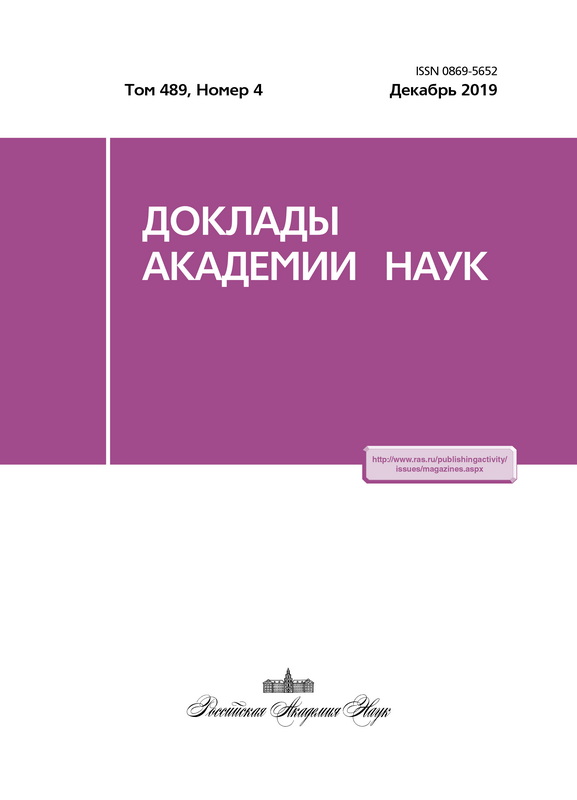On the modelling of the dissipation rate of turbulent kinetic energy
- Authors: Mortikov E.V.1,2, Glazunov A.V.1,2, Debolskiy A.V.1,3, Lykosov V.N.1,2, Zilitinkevich S.S.1,4,5
-
Affiliations:
- Lomonosov Moscow State University
- Marchuk Institute of Numerical Mathematics of the Russian Academy of Sciences
- Obukhov Institute of Atmospheric Physics of the Russian Academy of Sciences
- Finnish Meteorological Institute, University of Helsinki
- Institute of Applied Physics of the Russian Academy of Sciences
- Issue: Vol 489, No 4 (2019)
- Pages: 414-418
- Section: Geophysics
- URL: https://journals.eco-vector.com/0869-5652/article/view/18700
- DOI: https://doi.org/10.31857/S0869-56524894414-418
- ID: 18700
Cite item
Abstract
We consider a relaxation equation for turbulence wavenumber for use in semi-empirical turbulence closures. It is shown that the well-known phenomenological equation for the dissipation rate of turbulent kinetic energy can be related to this relaxation equation as a close approximation of the latter for stably stratified quasi-stationary flows. The proposed approach allows for more physically found definition of the empirical constants and improvement of atmospheric and oceanic boundary layer turbulence closures by using direct numerical and large eddy simulation data to define equilibrium states and relaxation mechanisms.
About the authors
E. V. Mortikov
Lomonosov Moscow State University; Marchuk Institute of Numerical Mathematics of the Russian Academy of Sciences
Author for correspondence.
Email: evgeny.mortikov@gmail.com
Russian Federation, 1, Leninskie gory, Moscow, 119991; 8, Gubkina street, Moscow, 119991
A. V. Glazunov
Lomonosov Moscow State University; Marchuk Institute of Numerical Mathematics of the Russian Academy of Sciences
Email: evgeny.mortikov@gmail.com
Russian Federation, 1, Leninskie gory, Moscow, 119991; 8, Gubkina street, Moscow, 119991
A. V. Debolskiy
Lomonosov Moscow State University; Obukhov Institute of Atmospheric Physics of the Russian Academy of Sciences
Email: evgeny.mortikov@gmail.com
Russian Federation, 1, Leninskie gory, Moscow, 119991; 3, Pizevsky, Moscow, 119017
V. N. Lykosov
Lomonosov Moscow State University; Marchuk Institute of Numerical Mathematics of the Russian Academy of Sciences
Email: evgeny.mortikov@gmail.com
Corresponding Member of the Russian Academy of Sciences
Russian Federation, 1, Leninskie gory, Moscow, 119991; 8, Gubkina street, Moscow, 119991S. S. Zilitinkevich
Lomonosov Moscow State University; Finnish Meteorological Institute, University of Helsinki; Institute of Applied Physics of the Russian Academy of Sciences
Email: evgeny.mortikov@gmail.com
Russian Federation, 1, Leninskie gory, Moscow, 119991; 1, Erik Palménin square, Helsinki, Finland, FI-00560; 46, Ulyanov street, Nizhny Novgorod, 603950
References
- Колмогоров А.Н. // Изв. АН СССР. Сер. физ. 1942. Т. 6. № 1/2. С. 56-68.
- Cuxart J., Holtslag A.A.M., Beare R.J., Bazile E., Beljaars A., et al. // Bound.-Layer Meteorol. 2006. V. 118. № 2. P. 273-303.
- Svensson G., Holtslag A.A.M., Kumar V., Mauritsen T., Steeneveld G.J., et al. // Bound.-Layer Meteorol. 2011. V. 140. № 2. P. 177-206.
- Burchard H. Applied Turbulence Modelling in Marine Waters. Berlin: Springer-Verlag Berlin Heidelberg, 2002. 218 p.
- Лыкосов В.Н. // Изв. РАН. Физика атмосферы и океана. 1992. Т. 28. № 7. С. 695-704.
- Mohamed M.S., LaRue J.C. // J. Fluid Mech. 1990. V. 219. P. 195-214.
- Schiestel R. // Phys. Fluids. 1987. V. 30. № 3. P. 722-731.
- Монин А.С., Обухов А.М. // Тр. Геофиз. ин-та АН СССР. 1954. Т. 24. С. 163-187.
- Глазунов А.В. // Изв. РАН. Физика атмосферы и океана. 2014. Т. 50. № 2. С. 156-165.
- Zilitinkevich S.S., Esau I., Kleeorin N., Rogachevskii I., Kouznetsov R.D. // Bound.-Layer Meteorol. 2010. V. 135. № 3. P. 505-511.
- Zilitinkevich S., Druzhinin O., Glazunov A., Kadantsev E., Mortikov E., et al. // Atmos. Chem. Phys. 2019. V. 19. P. 2489-2496.
- Mortikov E.V., Glazunov A.V., Lykosov V.N. // Russ. J. Numer. Anal. Math. Modelling. 2019. V. 34. № 2. P. 119-132.
- Glazunov A., Rannik Ü., Stepanenko V., Lykosov V., Auvinen M., et al. // Geosci. Model Dev. 2016. V. 9. P. 2925-2949.
- Beare R.J., Macvean M.K., Holtslag A.A.M., Cuxart J., Esau I., et al. // Bound.-Layer Meteorol. 2006. V. 118. № 2. P. 247-272.
Supplementary files







